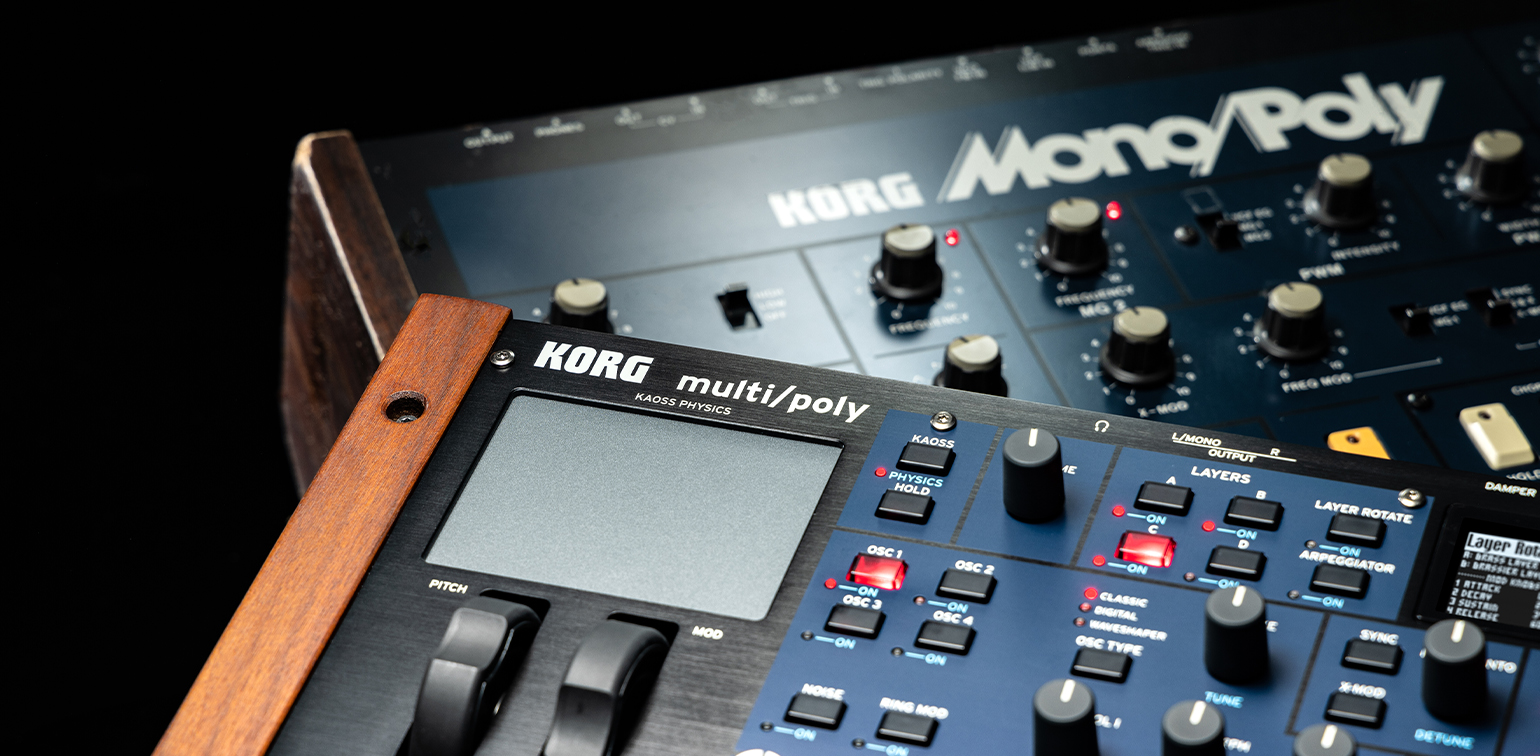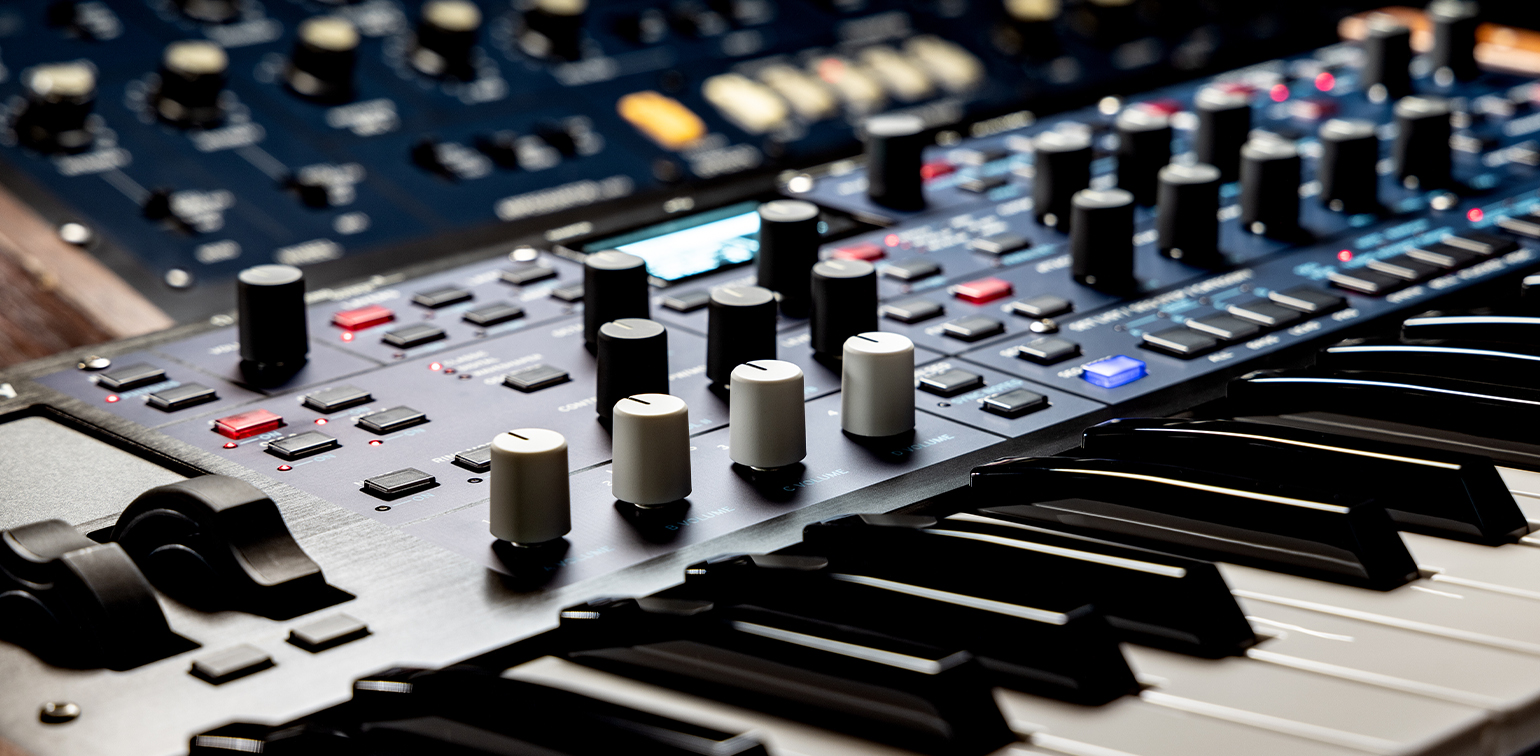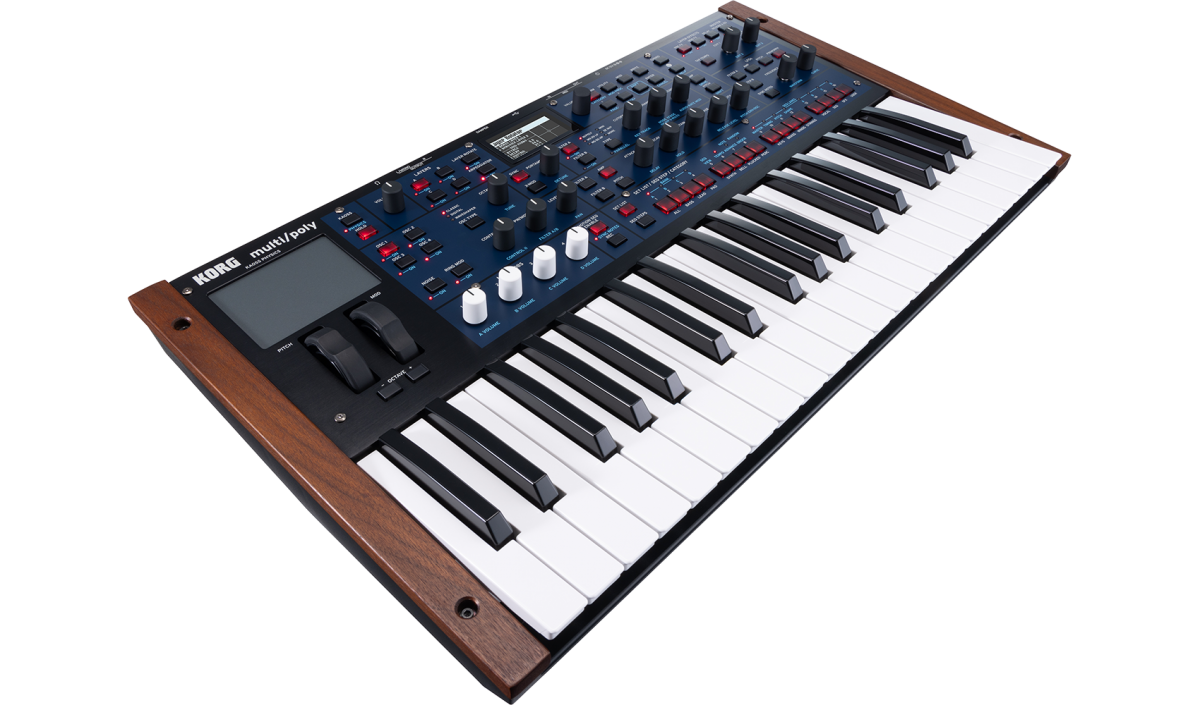

SoundCloud

multi/poly
ANALOG MODELING SYNTHESIZER
Support for Your Purchase
Learn More
Related Products
News
- 2025.05.20
- Updates - multi/poly and multi/poly module Editor/Librarian v1.0.9 is now available!
- 2025.03.06
- multi/poly native released – Intro Sale!
- 2025.03.06
- Updates - multi/poly and multi/poly module System Updater v1.0.4 is now available! Updates can be made using the KORG System Updater.
- 2025.01.29
- Updates - Korg System Updater v1.0.8 is now available!
Amazing analog sounds that only digital can provide
Inspired by the legendary KORG Mono/Poly, the new KORG multi/poly analog modeling synthesizer delivers breathtaking analog sounds combined with extraordinary digital power and flexibility.
The original Mono/Poly boasted an unusually rich sound from its four stacked oscillators, as well as unique, experimental features like flexible x-mod and sync routing and round-robin oscillator triggering. Previously only attainable in large modular systems, the Mono/Poly delivered these features in a compact, user-friendly instrument.
The new multi/poly is the first instrument to use KORG's next-generation analog modeling technology and builds on that legendary distinctive combination of big sounds and modular-derived experimental features. It's like a polyphonic modular system in a compact, hands-on package – a limitless playground for synth players and sound designers. Create hardware mash-ups with East-coast, West-coast, and wavetable oscillators and a wide selection of newly-modeled filters. Make them come alive with models of different envelope, VCA, and portamento circuits. Virtual voice cards produce organic timbral variation. Layer Rotate triggers new Programs with each press of a key. Plus Kaoss Physics, Motion Sequencing 2.0, massive modulation, and more.
Introduction
Overview

Next-level analog modeling
The multi/poly features redesigned, incredible-sounding filters and oscillators – and its advances in analog modeling go so much deeper. To start with, each voice has a Virtual Voice Card whose oscillators, filters, envelopes, LFOs, and portamento circuits model analog hardware component variations. The result is that each voice has a slightly different character, creating naturally rich timbres. Dial in as much or as little of this variation as you like, separately for each sound.
Just like in an analog synth, voice cards also continue to play even if you're not hearing them. Envelopes keep evolving, so that if you play a pad with a long release time, newly played notes "catch" the envelope at its current level instead of restarting from zero. Oscillators and LFOs maintain their phase, and resonance continues to ring. Each oscillator’s pitch can also drift slightly over time, modeling the slight pitch instabilities found in analog hardware.
Envelopes are an often-overlooked factor that contributes to the unique sounds of vintage synths. The multi/poly includes envelope curvature presets for the Mono/Poly, MS-20, "Mini," "Pro," ARP Odyssey, and more. Also, analog VCAs don’t respond evenly to voltage, and have different thresholds for turning on and off, which in turn has a strong effect on the Amp Envelope's character. So, the multi/poly features modeled VCA responses from the Mono/Poly, MS-20, Mini, Odyssey, and Prophet 5, as well as a linear option.
Ever tried to re-create a portamento effect from a favorite song, but couldn't find the right setting even when you switched between "constant rate" and "constant time?" Classic analog synths had different approaches to portamento, too, and so the multi/poly has six different portamento models to choose from.

Oscillators
The multi/poly offers FOUR oscillators per Program, for unusually thick, complex tones. Each can use the Classic, Digital, or Waveshaper oscillator types. The Classic oscillator models traditional analog synth oscillators with stunning fidelity and effortless thickness. 11 options include both single and dual waveforms, for modeling synths that generated multiple waveforms at once. Front panel knobs give you hands-on control of pulse width, triangle "lean", dual-waveform blend, and more.
The Digital oscillator plays wavetables with up to 64 steps, like vintage hybrid synths and modern eurorack modules. Start with over 200 factory wavetables, or load your own using the Editor/Librarian software for macOS and Windows. Import modwave wavetables directly, or convert wavetables from popular software formats. Use the 30+ Modifiers to change the way that the tables are loaded, resulting in subtle to extreme changes in timbre, and 8 Morph Types like Stretch, Flip, and Mirror to process them in real-time.
Waveshaper offers a "West-Coast" approach, in which simple waveforms (sine or triangle) are processed through a shaper table. Modulating gain into the shaper creates glassy, dynamic harmonics. Use the Berkeley shaper for traditional wavefolder timbres, or select from over 90 other shaper types. The multi/poly also adds modulatable pulse width, a unique twist, for another dimension of richness and motion.
In addition to oscillators 1-4, there's a separate noise generator with dedicated filtering and saturation, and a ring modulator with inputs from all of the above.
The multi/poly also expands on the original Mono/Poly's powerful oscillator sync and x-mod capabilities, for timbres otherwise only possible with a large modular setup. Create unique sounds with Oscillators 2, 3, and 4 simultaneously following Oscillator 1 for sync, x-mod, or both at once. Alternatively, split either function into oscillator pairs with separate control.

Dual modeled filters
All of the multi/poly's filters are newly redesigned, including an amazing suite of vintage filters with authentic euphonic saturation. To start with, there are five different 4-pole self-resonating models. M/Poly provides the strong, sweet sound of the classic Korg Mono/Poly. Mini is the ladder filter from a beloved American mono-synth; resonance is reduced at low frequencies, critical for producing those classic bass sounds. Pro is from the first programmable polyphonic synthesizer, with strong resonant sweeps all the way down. Finally, Ladder HP and BP are 4-pole self-resonating highpass and bandpass filters, respectively.
The MS-20 LP and HP 12dB/octave self-resonating "Korg 35" filters lovingly recreate the distinctive, aggressive timbral signature of the classic Korg MS-20. The SE M/P 2-pole filter is more gentle in character, and features a continuous control to sweep between lowpass, band reject, and highpass, plus a separate bandpass mode.
You can also shape and refine with a full collection of linear, resonant 2-pole and 4-pole lowpass, highpass, bandpass, and band reject filters. Or, step outside the box with KORG’s unique Multi Filter, which creates modulatable blends of multiple modes simultaneously.
All of these filters support audio-rate modulation for ear-catching bright, fizzy, and bubbling effects. Use any of the oscillators or the ring modulator as the modulation source, and even blend in the noise generator for more chaotic timbres. In addition to the vintage filters' built-in saturation, a post-filter anti-aliased Drive circuit lets you add more weight and grit to taste, from subtle thickening to heavy distortion.
Finally, you can use any two of these filters simultaneously, in series or in parallel. Programs have two filter slots, A and B. Each source, including the four oscillators, noise, and ring Mod, has a balance control which crossfades between the two filters–enabling a wide array of creative options. For instance, send one group of oscillators through the M/Poly filter, and the other through the MS-20 lowpass. Create a classic highpass->lowpass serial chain, but route one or more oscillators around the highpass. Since this is a continuous crossfade, and not just a switch, you can modulate the A/B Balance for unique effects. The filters can also run in stereo, with separate panning for each of the sources.
.
Each Program starts with four oscillators plus a noise generator, ring mod, sync, and x-mod. Process these through two independent filters, and modulate with four loopable DAHDSR envelopes, five LFOs, and six Mod Processors. Add complex per-voice motion with multi-lane Motion Sequencing 2.0, and polish with three studio-quality insert effects.
But, that's just a single Program. Layer up to four Programs in a Performance. Switch between them round-robin style using Layer Rotate, either played from the keyboard or driven from the arpeggiator. Use Kaoss Physics to create fluid, evolving modulation from simple gestures on the x/y pad. Grab the four Mod Knobs for intuitive, hands-on control of multiple low-level parameters. Put on the finishing touches with two more Mod Processors, Master Reverb, and EQ.

Layer Rotate
The multi/poly has four Layers, each of which contains a Program. Naturally, these can create layered sounds, velocity splits, and keyboard splits. Inspired by the original Mono/Poly’s paraphonic mode, which cycled through its four oscillators, Layer Rotate adds a new possibility: flexible round-robin for entire Programs.
Set up the four Layers with different Programs, and then cycle through them with each key-press. Play them in repeating or random order. Trigger one, two, or three Programs at every step of the cycle. Use Layer Rotate together with the arpeggiator for mind-bending patterns.

Modulation and control
Bursting with knobs and controllers, the multi/poly invites you to explore. Oscillators, filters, envelopes, LFOs, and effects are all at your fingertips with dedicated front-panel controls. Four programmable Mod Knobs are customized to bring out the most in every sound. Use the knobs in realtime performance, and also save the results as new sounds. The Hold button lets you sustain notes or chords indefinitely, while you explore the front-panel controls or play other gear.
Add in Kaoss Physics and the Pitch Bend and Modulation Wheels, and you’ll always have multiple dimensions of realtime expression.
Want to dig deeper? Almost all front-panel knobs, and most on-screen parameters, can be modulated, for an astonishing total of over 5,500 modulation destinations. You can even modulate individual Motion Sequence Steps! Eight Mod Processors let you transform modulation signals using quantization, smoothing, curvature, and more.

Motion Sequencing 2.0
Motion Sequencing 2.0 evolved from the wavestate’s Wave Sequencing 2.0. Timing, Pitch, Shape, and four sets of Step Sequence values are separated into “Lanes,” each with their own loop start and loop end, adding a deeper, more customizable level of phrase and modulation recording.
Every time the sequence moves forward, the individual Lanes are combined to create the output. For instance, a step sequence value may be matched with a different duration, pitch, and shape every time that it plays. You can modulate each Lane’s loop points separately for every note, using velocity, LFOs, envelopes, Mod Knobs, or other controllers. Each note in a chord can be playing something different!
Lanes can also randomize the step order every time they play. Individual steps can be randomly skipped, with a modulatable probability from 0 to 100%. The result is organic, ever-changing sounds that respond to your control.
Kaoss Physics
Kaoss Physics models a ball rolling on a surface and bouncing off of walls. The surface can tilt in any direction. A bump with variable height/depth and location attracts or repels the ball. Adjustable friction slows the ball's travel, and adjustable time controls the speed of the entire model. All of these characteristics are modulatable, so you can change them in real-time.
Start the ball by flicking a finger on the x/y pad, or launch the ball automatically using another modulation source. You can also directly control the ball by holding your finger on the pad. The position of the ball produces eight modulation signals, which can be used to control any modulation destination: the X and Y locations, the distance from the center, the angle relative to the X axis, and finally separate signals for +/- X and +/- Y.
Walls can slow down the ball, as if they were padded, or accelerate the ball, like bumpers in a pinball machine. The walls can also be removed entirely, so that the surface wraps around to the opposite edges like a vintage arcade game.
The modeled environment can create specific modulation effects. For instance, use a centered bump with negative height so that the modulation values always eventually return to 0. Or, position a bump with positive height on a side or a corner, to push modulation values away from that zone.
The result is an interactive controller that amplifies your physical gestures, transforming them into complex musical results. It's fun, too!

Production-Ready Effects
The multi/poly’s superb effects deliver production-ready sounds. Each Layer has three dedicated effects, plus a send to the Performance's master reverb, followed by a master parametric EQ. Along with standard effects such as compressors, EQs, choruses, flangers, phasers, and stereo delays, you’ll find distinctive processors such as the Wave Shaper, Talking Modulator, Reverse Delay, Multiband Mod Delay, and Overb (from the OASYS and Kronos), plus modeled effects including VOX guitar amps, VOX wah, Vintage Distortion, CX-3 Rotary Speaker and Vibrato/Chorus, multi-head tape echo, and a collection of classic guitar pedals.
Randomization that inspires
Looking for even more inspiration? A dedicated front-panel button, marked by a “dice” icon, generates new sounds via intelligent randomization. Randomize the entire sound or just a part of it, such as the oscillators, filter, or effects. Use the results directly, or as a jumping-off point for your own creations.

Set Lists and Smooth Sound Transitions
Set Lists offer effortless organization of your multi/poly Performances, and deliver instant access at the gig or in rehearsal. Smooth Sound Transitions allow previously-played voices and effects to continue to ring out naturally, even once a new sound has been selected.
Connections
Balanced stereo outputs connect to any recording or monitoring system, and a stereo headphone output is great for private playing or onstage cueing. Din-style MIDI jacks ensure connection to other MIDI-equipped instruments and audio gear, and USB supports class-compliant MIDI with Windows and macOS computers.

Editor/Librarian software
The multi/poly Editor/Librarian lets you edit and organize sounds via your macOS or Windows computer. Using USB networking for high-speed communication, it works like a second front panel for the instrument, so there's no need to synchronize or transfer data. Animations show the effects of modulation in real-time - a great help when programming.
Free bundle of music software
The multi/poly comes with a diverse collection of music software to help you take your music to the next level, including Izotope's Ozone Elements for AI-powered mastering, Skoove for improving your keyboard playing skills, and software synths from KORG and other brands.

Soft case included

Built to play - and to last
An instrument that sounds this great deserves to look and feel fantastic, too. The new semi-weighted keybed is smooth and expressive, and knobs with just the right amount of resistance are perfect for dialing in your sounds. The solid aluminum front panel is built for the road, and the wooden side-panels and blue-on-black color scheme shout out to the original Mono/Poly design.


















